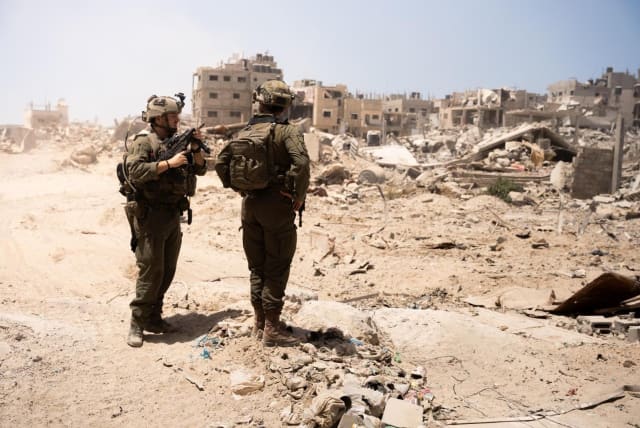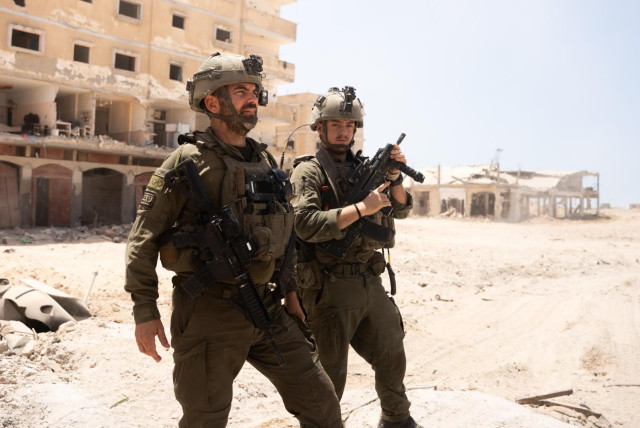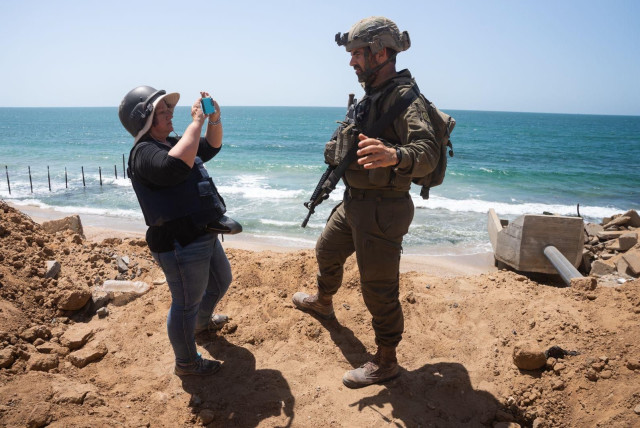'Post' in Rafah: 'No home without a tunnel,' says Nahal Brigade commander

The Jerusalem Post's Tovah Lazaroff was in Gaza to find out more about the extent to which Hamas has integrated itself into civilian areas.
A white cat walking across a partially destroyed building in Rafah’s Shabura refugee camp was the only civilian remnant of the Gaza neighborhood by the Egyptian border, which until the start of May had been crowded with Palestinians.
A bullet-riddled Sonol sign still hung on top of the rubble of what had once been a gas station.
Half destroyed concrete buildings stood, in some cases reduced to framed shells, intermixed with piles of rubble.
Large swaths of sand, covered what had once been paved roads, giving Shabura a dustbowl appearance.
The IDF brought a small number of reporters in a Humvee into this desert landscape on Tuesday, to speak with Nahal Brigade Commander Colonel Yair Zuckerman about the extent to which Hamas has integrated itself into the civilian area.
Just one week earlier, four IDF soldiers were killed when a bobby-trapped building exploded in this neighborhood. Now, however, an empty silence hung heavy under the bright afternoon sun, broken only by the soldiers on the road and the nearby tanks and tractors.
Zuckerman met with reporters on what he said was the 41st day of the battle for Rafah, in one of the more intact buildings in the neighborhood, whose occupants had fled.
Wearing a khaki uniform and flak jacket, he sat with them in what had once been a large second-floor apartment.
The windows were covered by blankets. The only civilian remnant in the room was a small sofa, with wooden trim and light brown fabric.
Soldiers had written on the white walls directional signals in Hebrew: North, south, east, and west.
The electricity was run by a generator, which hummed during the entire conversation and was broken several times with distant sounds of explosions.
The table in front of Zuckerman was filled with computers. Using the wall as a screen he mapped out how, soldiers had been able to enter Rafah, staying one step ahead of Hamas strategically.
Never-ending tunnels in Rafah, posing challenges to the IDF
“Rafah is chock-filled with tunnels,” he said, adding that, “During the last days alone, I found 17 tunnels.”
“There is almost no home without a tunnel,” he said, as he explained that the tunnels connected the homes in the neighborhood in one vast labyrinth. Holes were also broken through the walls to connect them, he said.
To illustrate his point, he showed a photograph with an open closet door and behind it, a hole in the concrete wall.
Homes are boobytrapped with wired explosives that can be detonated at a distance, Zuckerman said, as he referenced the incident last week in which four soldiers were killed when the bomb was set off in a home believed to be free of such devices.
This is a different kind of battlefield, as he described the methodical inch-by-inch fighting that has taken place in Rafah, where soldiers are battling above and below ground.
“It’s slow and painstaking,” he said, but the achievements "are significant.”
Soldiers have found caches of weapons, rocket-propelled grenades, and long-range rockets, Zuckerman explained, as he argued that it was important that the IDF be given time to complete its mission of demilitarizing the area.
The soldiers here “understand that this existential problem rests on their shoulders,” Zuckerman said, as he described a situation in which a myriad of small almost indiscernible successes, would ultimately lead to complete victory.
He did not want to quantify how long it would take to complete the mission, just that it was important to finish the job.
“We don’t want to leave until we have solved the problem,” he said.
IDF operating in Rafah since May
An estimated 1.2 to 1.4 million Palestinians had taken refuge in Rafah since the outbreak of the war. The military subsequently stated it had evacuated 80% of the population from the area.
Amid international opposition, the IDF took the Palestinian side of the Rafah crossing on May 7, attaining full operational control of the crossing. The military has since been engaged in operations in the area.
Israel had maintained the importance of operating in Rafah to eliminate the last four Hamas battalions, which it believed were still in the region.
The Israel-Hamas war began on October 7 when Hamas launched an attack, in which thousands of terrorists infiltrated from the Gaza border and took more than 240 hostages into the Gaza Strip.
During the massacre, more than 1,200 Israelis and foreign nationals were murdered, including over 350 in the Re'im music festival and hundreds of Israeli civilians across the Gaza border communities.
120 hostages still remain in Gaza captivity.
Jerusalem Post Store
`; document.getElementById("linkPremium").innerHTML = cont; var divWithLink = document.getElementById("premium-link"); if (divWithLink !== null && divWithLink !== 'undefined') { divWithLink.style.border = "solid 1px #cb0f3e"; divWithLink.style.textAlign = "center"; divWithLink.style.marginBottom = "15px"; divWithLink.style.marginTop = "15px"; divWithLink.style.width = "100%"; divWithLink.style.backgroundColor = "#122952"; divWithLink.style.color = "#ffffff"; divWithLink.style.lineHeight = "1.5"; } } (function (v, i) { });


